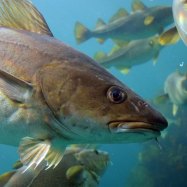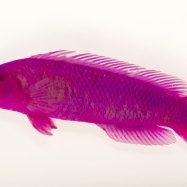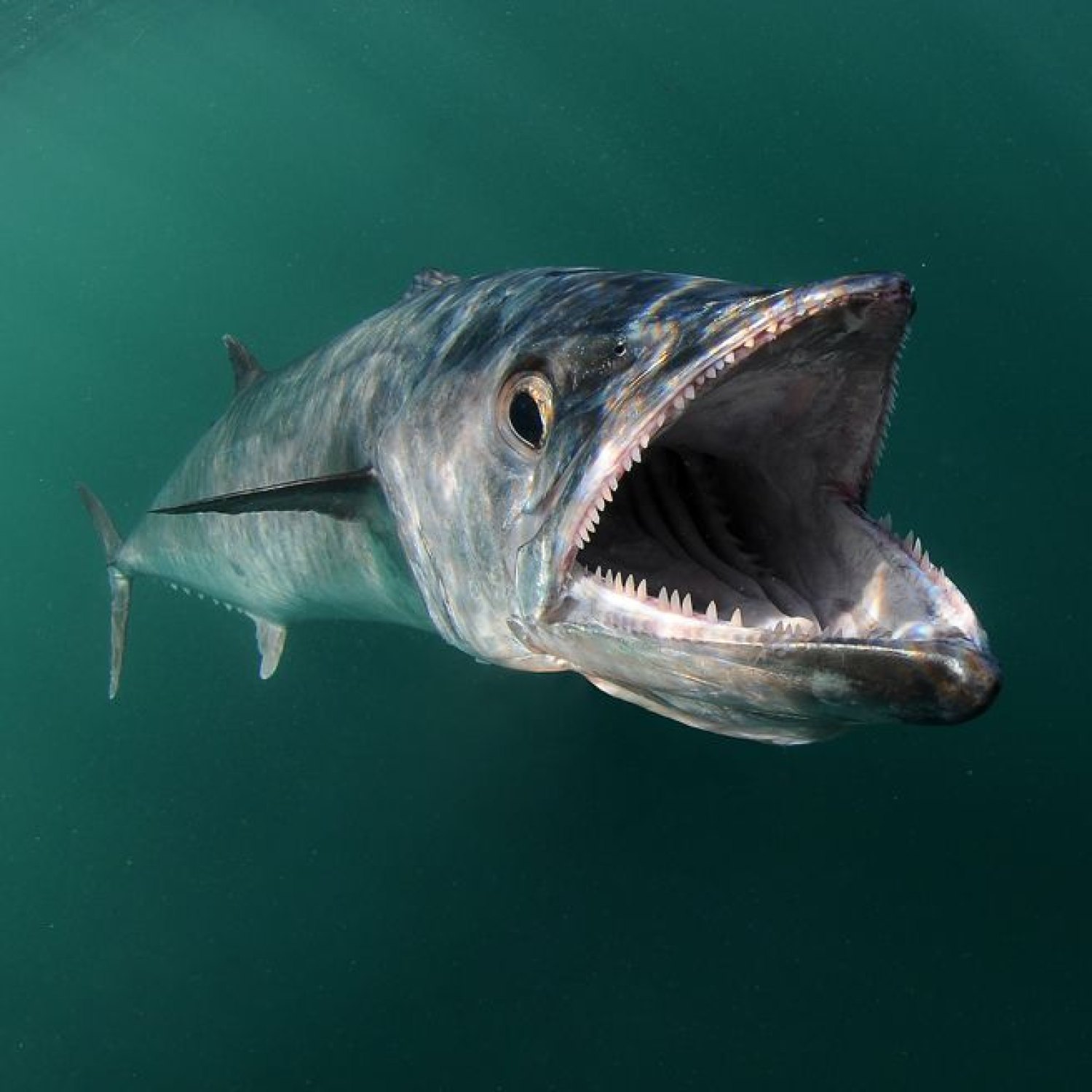
King Mackerel
Up to 5 feet (1.5 meters)
Discover the majestic King Mackerel that can grow up to 5 feet long! Found in the Gulf of Mexico, this sleek and streamlined fish, belonging to the Scombridae family, is a sought-after catch for anglers and a prized delicacy for seafood lovers. #KingMackerel #GulfOfMexico #Scombridae #Seafood
Animal Details Summary:
Common Name: King Mackerel
Kingdom: Animalia
Habitat: Coastal waters
The Mighty King Mackerel: A Coastal Predator
The ocean is home to a vast array of fascinating creatures, from the giant blue whale to the colorful clownfish. Among these sea-dwellers is the impressive King Mackerel, a fierce and majestic fish that rules the coastal waters of the Atlantic Ocean. Scientifically known as Scomberomorus cavalla, this species of mackerel is commonly referred to as simply the King Mackerel. Let's dive into the depths of the sea and explore the fascinating characteristics of this formidable predator King Mackerel.Kingdom: Animalia
Like all animals, the King Mackerel belongs to the kingdom Animalia. This kingdom is comprised of millions of diverse species that share similar characteristics. These include being multicellular, having specialized cells, and the ability to obtain and digest food. Within this kingdom, the King Mackerel is classified under the phylum Chordata.Family: Scombridae
The King Mackerel belongs to the family Scombridae, also known as the mackerel family. This family includes other well-known fish species such as tuna and bonito. Members of the Scombridae family share similar characteristics, including an elongated body with compressed sides, deeply forked tail fins, and the ability to swim at high speeds.Order: Perciformes
The King Mackerel is classified under the order Perciformes, which includes over 41% of all fish species. Perciformes are characterized by having a single dorsal fin, a centrally located anal fin, and pectoral fins located behind the gills Kerry Blue Terrier. The King Mackerel is also in the same order as other popular sport fish, such as snapper and bass.Habitat and Distribution
The King Mackerel is a migratory fish that can be found in the coastal waters of the Atlantic Ocean, from the Gulf of Mexico to North Carolina. These fish prefer warm waters and can be found at depths ranging from the surface to 130 feet (40 meters). They are highly adaptable and can also be found in bays, estuaries, and near coral reefs.Feeding Habits of the King Mackerel
As carnivorous predators, King Mackerels have a sharp eye for their next meal. They primarily feed on smaller fish such as sardines, anchovies, and menhaden. Their strong and agile bodies allow them to swiftly chase and capture their prey. They also have sharp teeth that enable them to grasp and pierce through their meals.In addition to smaller fish, King Mackerels also feed on squid, shrimp, and crab. They are opportunistic predators and will eat almost anything that crosses their path. This makes them an essential part of the ocean's food chain, regulating the population of smaller fish and keeping the ecosystem balanced.
Appearance: A Regal Fish with Streamlined Body
The King Mackerel is a visually striking fish with a streamlined body that is built for speed. They have a pointed head and a torpedo-shaped body, perfect for slicing through the water at an impressive speed. Their body is covered in small, silvery scales that reflect the light, making them shimmer like jewels.The coloration of the King Mackerel is also a sight to behold. Their back is a vibrant blue-green, blending in perfectly with the ocean's depths. This color fades into a silvery tone on their sides, while their belly is a brilliant white. This coloring helps them blend into their surroundings, making them excellent hunters and keeping them safe from potential predators.
The King Mackerel's Length and Weight
King Mackerels can grow up to an impressive 5 feet (1.5 meters) in length and can weigh up to 100 pounds (45 kilograms). However, the average size of King Mackerels caught by sport fishermen is around 30 pounds (13.6 kilograms). These fish have a lifespan of 10-13 years and can reach maturity by the age of 3-5 years.King Mackerel in the United States
The King Mackerel is native to the United States and is mainly found in the Gulf of Mexico and off the coast of Florida. They are also found in the Carolinas and as far as Massachusetts during summer months. The fish population in the U.S. is well-managed, and the Florida Fish and Wildlife Conservation Commission regulates fishing limits to ensure sustainable populations.King Mackerel Fishing
The King Mackerel is a highly sought-after game fish, making it a popular target for sport fishermen. With their incredible speed and strength, these fish put up a thrilling fight when hooked, making them a prime target for anglers. King Mackerel fishing is a popular activity in the Gulf of Mexico and along the Atlantic Coast, with tournaments held in various locations throughout the year.The King Mackerel: A Delicacy on the Table
Not only are King Mackerels exciting to catch, but they are also delicious to eat. These fish have a firm, flaky flesh that is high in protein and rich in omega-3 fatty acids. They are often described as having a similar taste and texture to tuna or swordfish.King Mackerel can be prepared in various ways, including grilling, baking, or pan-searing. They are also commonly smoked, making for a tasty treat. However, it is essential to keep in mind that King Mackerels have a moderate level of mercury, and it is recommended to consume them in moderation.
In Conclusion
In conclusion, the King Mackerel is a fascinating fish with impressive features that make it one of the most formidable predators in the ocean. From its striking coloration to its impressive speed and strength, this fish is truly a masterpiece of evolution. Its presence in the coastal waters of the Atlantic Ocean is essential to maintaining a healthy ecosystem, and its popularity among sport fishermen makes it a prized catch for anglers. Next time you're near the shore, keep an eye out for the mighty King Mackerel, and appreciate the incredible creature it is.

King Mackerel
Animal Details King Mackerel - Scientific Name: Scomberomorus cavalla
- Category: Animals K
- Scientific Name: Scomberomorus cavalla
- Common Name: King Mackerel
- Kingdom: Animalia
- Phylum: Chordata
- Class: Actinopterygii
- Order: Perciformes
- Family: Scombridae
- Habitat: Coastal waters
- Feeding Method: Carnivorous
- Geographical Distribution: Atlantic Ocean
- Country of Origin: United States
- Location: Gulf of Mexico
- Animal Coloration: Blue-greenish on the back, silvery on the sides
- Body Shape: Streamlined
- Length: Up to 5 feet (1.5 meters)
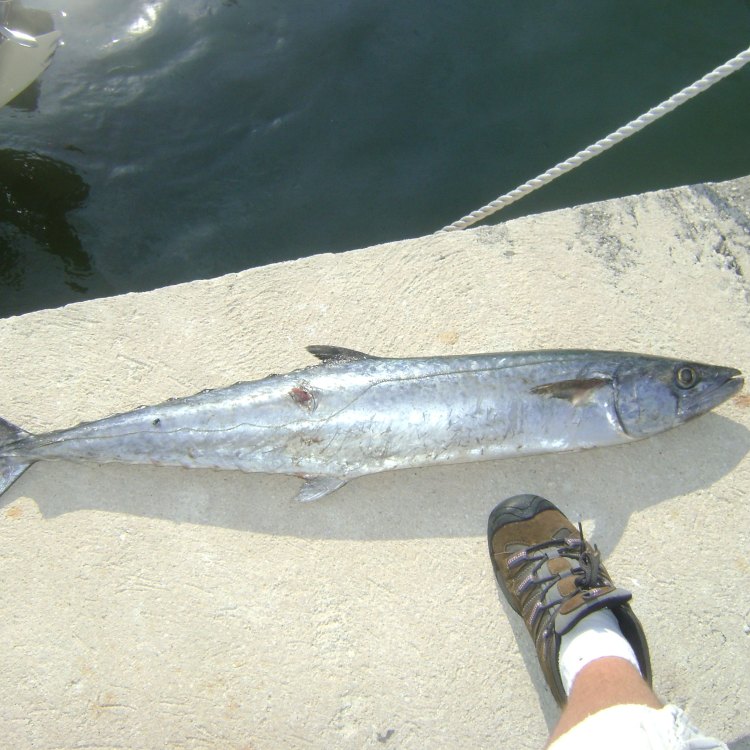
King Mackerel
- Adult Size: 40 to 70 pounds (18 to 32 kilograms)
- Average Lifespan: Around 20 years
- Reproduction: Sexual
- Reproductive Behavior: Spawning
- Sound or Call: N/A
- Migration Pattern: Seasonal migration
- Social Groups: Solitary or in small groups
- Behavior: Aggressive when feeding
- Threats: Overfishing, habitat loss
- Conservation Status: Not listed
- Impact on Ecosystem: Top predator, helps maintain balance in marine ecosystems
- Human Use: Commercial and recreational fishing
- Distinctive Features: Mackeral-like shape, sharp teeth
- Interesting Facts: King mackerel is known for its fast swimming speed and powerful strikes.
- Predator: Sharks, larger predatory fish
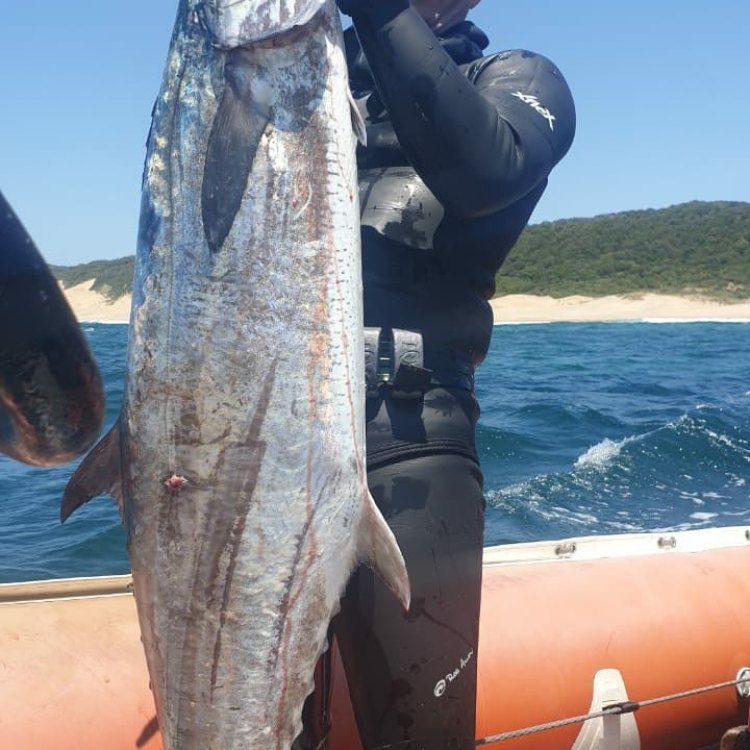
Scomberomorus cavalla
The King Mackerel: A Top Predator of the Ocean
The ocean is known for its vast biodiversity, with countless species of fish and marine animals inhabiting its waters. Among these diverse creatures is the King Mackerel, also known as the kingfish, a predatory fish with a regal name and formidable presence.The King Mackerel, or Scomberomorus cavalla, is a type of mackerel found in the western Atlantic Ocean, from the Gulf of Mexico to the Carolinas, and in the eastern Atlantic from the Canary Islands to Senegal. They are highly valued by both commercial and recreational fishermen for their large size, fast swimming speed, and delicious taste PeaceOfAnimals.Com. In this article, we will delve into the unique features and behaviors of the King Mackerel and its impact on the ocean's ecosystem.
Distinctive Features and Behavior
The King Mackerel is a large fish, with adults ranging from 40 to 70 pounds (18 to 32 kilograms) and can reach lengths of up to 5 feet. They have a typical mackeral-like shape, with a streamlined body and sharp, conical teeth. This allows them to be efficient predators, capable of devouring their prey in one swift strike.Like most mackerels, the King Mackerel also have a distinctive metallic blue-green color on their backs, fading to silver on their sides and belly. This makes them a visually stunning fish, especially when seen swimming in schools with their metallic scales glinting in the sunlight.
They are known for their fast swimming speed, reaching speeds of up to 40 miles per hour. This enables them to chase and catch their prey, which primarily consists of small fish like mullet, herring, and anchovies. They are also known to eat crustaceans, squid, and even other smaller mackerel King Rat Snake.
The King Mackerel's behavior is predominantly solitary, with adults often seen swimming alone or in small groups. They are also known to be territorial fish, especially during feeding time, where they can become quite aggressive.
Reproduction and Lifespan
The King Mackerel's reproductive behavior is similar to most fish, with sexual reproduction and the release of eggs and sperm into the water for fertilization. However, unlike some fish species, the King Mackerel has a specific spawning season, where they gather in large numbers and lay their eggs in offshore waters.During the spawning season, which typically occurs from early spring to summer, the King Mackerel migrates to deeper offshore waters, about 30 to 100 miles off the coast. This behavior allows for better chances of survival for their offspring, as the eggs are less likely to be eaten by predators and have a higher chance of hatching successfully.
The King Mackerel also has an average lifespan of around 20 years, making them a long-lived species compared to other fish. This extended lifespan is due to their large size and their position as top predators in the ocean's food chain.
Human Use and Impact on Ecosystem
The King Mackerel is a highly sought after fish in both commercial and recreational fishing. Their large size, fast swimming speed, and delicious taste make them a prized catch for fishermen. In the United States, they are mostly caught using traditional hook and line methods, with some commercial fisheries also using gillnets.Their popularity in the fishing industry has led to concerns over their sustainability, with overfishing being the most significant threat to their population. Despite not being listed as an endangered species, monitoring and management efforts are in place to ensure their numbers do not decline.
Aside from their economic significance, the King Mackerel also plays a crucial role in maintaining balance in marine ecosystems. As a top predator, they help control the population of smaller fish and maintain a healthy balance within their ecosystem.
Threats and Conservation Status
The King Mackerel faces various threats, with overfishing being the most significant concern. The increase in demand for their meat has led to a decline in their population, with some fisheries reporting a 30% decrease in their catch over the past decade. Other threats include habitat loss due to human activities such as coastal development and pollution.Despite these threats, the King Mackerel is not currently listed as endangered or even threatened. However, monitoring and management efforts are essential to ensure their population remains stable and healthy.
Interesting Facts
Besides its impressive size and powerful strikes, the King Mackerel has many interesting facts that make it stand out among other fish species. Due to its fast swimming speed, it is often referred to as the "bullet of the sea," and it is one of the fastest fish in the ocean, rivaling even the renowned sailfish.Another interesting fact is that the King Mackerel is a favorite prey for larger predatory fish, such as sharks and other large fish like tuna and marlin. This adds to their already formidable reputation as a powerful predator of the ocean.
In Conclusion
The King Mackerel is an impressive and truly unique fish, with its distinct features, behaviors, and status as a top predator of the ocean. Its value to both the fishing industry and the marine ecosystem is undeniable, and efforts must be made to ensure its sustainability for future generations.As we continue to explore the wonders of the ocean, let us not forget the importance of preserving and protecting its diverse inhabitants, including the magnificent King Mackerel.

The Mighty King Mackerel: A Coastal Predator
Disclaimer: The content provided is for informational purposes only. We cannot guarantee the accuracy of the information on this page 100%. All information provided here may change without prior notice.


